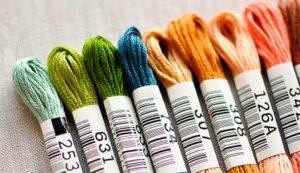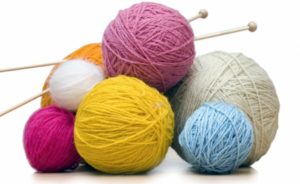Sometimes in a store you can get confused by the number of threads offered in various colors, thicknesses and markings. How they differ from each other, what they are like and what to look for when choosing, read on.
Classification of threads by purpose
 Threads are usually called very thin, evenly twisted, extended yarn, which has special properties for performing the tasks assigned to it.: sewing, embroidery, knitting. According to their purpose, threads are divided into the following types:
Threads are usually called very thin, evenly twisted, extended yarn, which has special properties for performing the tasks assigned to it.: sewing, embroidery, knitting. According to their purpose, threads are divided into the following types:
- sewing;
- embroidery;
- knitting.
For sewing
Clothes are sewn from the material using threads. The main purpose of these twisted products is to sew together cut out pieces of clothing.. To attach them to each other, threads are used, which are called sewing threads. Most often they are made from natural materials, but synthetic ones are also in great use.
The thickness (fineness) can be different, it depends on the purpose of the product.For home sewing, they are wound on reels, and for production volumes - on bobbins.
Quality products of this type are characterized by the following properties:
- high tensile strength;
- smoothness and evenness;
- uniformity of twisting;
- heat resistance;
- resistance to adverse environmental influences.
Important! Sewing threads should under no circumstances shed or shrink. When a decorative seam sheds, the skirt or dress can be thrown away, and the shrinking internal seams will pull. Correcting these shortcomings is problematic, so use them only for outline work.
Also pay attention to the smallest particles of lint that may be present in twisted products. This is an indicator of low quality. This especially affects old threads that were bought by grandmothers in the last century, but these huge bobbins are still used by all relatives. It is better to purchase a modern copy that meets all the listed requirements.
For embroidery
 The main purpose of these threads is to decorate the fabric with various patterns and ornaments, made in color or in different shades. Threads for machine and hand embroidery are different.
The main purpose of these threads is to decorate the fabric with various patterns and ornaments, made in color or in different shades. Threads for machine and hand embroidery are different.
Home needlewomen use embroidery floss. They are loosely twisted from six components and can be easily separated if necessary. Available in skeins of 10 and 20 meters from specially treated cotton with a durable color. Resistance to mechanical stress is not in the first place here, but the requirements for smoothness and evenness are high. Also, the thread should not twist or get tangled.
Important! Floss with a glossy surface and a uniform shiny structure is more in demand than the matte variety.Ornaments and designs embroidered with glossy floss look very elegant and resemble silk.
For knitting
Threads of this type are used for machine and hand knitting. Manufacturers offer yarn of different thicknesses, lengths and composition. Knitting threads can be wool, synthetic or mixed.
Important! Combining natural and artificial fibers into one thread makes the yarn stronger, more wear-resistant, soft, pleasant to the touch, and affordable without compromising the quality of wool.
Handwork is done by knitting or crocheting. And if yarn of any degree of twist is suitable for a hook, then on knitting needles a high twist will warp the knitted product. Typically, yarn recovered from wool fibers, which is inexpensive and therefore popular, suffers from this disadvantage.
Types of threads by composition
Threads can consist of fibers of different origins:
 natural - for example, cotton, linen, bamboo, silk, wool;
natural - for example, cotton, linen, bamboo, silk, wool;- chemical - polyamide, polyester, polypropylene;
- combined - cotton with polyester, viscose with polyamide and acetate, reinforced threads.
Polyester
It can be difficult to distinguish artificial fiber from cotton by appearance, they are so similar. But polyester thread is cheaper and has better consumer qualities. It is more stretchable, can be subjected to significant mechanical loads, has increased strength and has proven itself in the sewing industry. In addition, it is not afraid of moisture, it is not subject to rotting.
Cotton
This is the most popular natural raw material for the production of sewing threads. They are used for absolutely all sewing operations, for basting the product and securing all types of seams.Cotton is also the basis for floss, and using knitting needles or a crochet hook from cotton yarn you can knit a light sweater or blouse for your summer wardrobe.
Polyamide
 Fibers belonging to this type - nylon, silone, nylon - are distinguished by high wear resistance, abrasion resistance and increased thread strength. The raw materials for them are oil, natural gas, and coal. They the most tensile strength, but at the same time have elasticity. Knitting knitted with wool or cotton fibers also looks great, adding shine to the matte yarn.
Fibers belonging to this type - nylon, silone, nylon - are distinguished by high wear resistance, abrasion resistance and increased thread strength. The raw materials for them are oil, natural gas, and coal. They the most tensile strength, but at the same time have elasticity. Knitting knitted with wool or cotton fibers also looks great, adding shine to the matte yarn.
Reinforced
These are the strongest products of all of the above. Reinforcement is the process of increasing the strength of one material connected to another. Reinforced threads have a core of polyester fiber braided with cotton, lavsan or siblon. The twist produced in this way is incredibly strong and durable.
Important! Reinforced threads are used in sewing industrial protective clothing for the military and firefighters, as well as in cosmetology for thread lifting - tightening sagging facial tissues.
Varieties by material
Sewing threads are made from different raw materials:
- natural - cotton, linen, silk;
- artificial - from nylon (polyamide), polyester (lavsan).
Natural
 They are characterized by high consumer properties, which, despite more expensive raw materials and labor-intensive production, are used in sewing children's clothing, in small workshops and for home handicrafts. Good appearance, evenness, smoothness, and during mercerization - the acquisition of additional strength and shine - these are the properties for which the consumer appreciates natural threads.
They are characterized by high consumer properties, which, despite more expensive raw materials and labor-intensive production, are used in sewing children's clothing, in small workshops and for home handicrafts. Good appearance, evenness, smoothness, and during mercerization - the acquisition of additional strength and shine - these are the properties for which the consumer appreciates natural threads.
Synthetic
These sewing threads are also quite good and are successfully used, replacing not only silk, which has almost been replaced by artificial ones, but also cotton. Knitting natural yarn also competes with synthetic analogues. However The property of wool to retain heat is unique, so it is combined with artificial fiber, obtaining fairly high-quality and less expensive products.
How are threads marked?
 Each reel is sold with a product number. Threads are marked with numbers from 10 to 100. The highest number of the product number indicates the thinnest thread. For example, outerwear is sewn with thread No. 20, and a light cotton dress will use No. 40 or 50.
Each reel is sold with a product number. Threads are marked with numbers from 10 to 100. The highest number of the product number indicates the thinnest thread. For example, outerwear is sewn with thread No. 20, and a light cotton dress will use No. 40 or 50.
Reinforced threads are also marked:
- LL – where the first L means that the core is polyester fiber, and the second L is a lavsan (polyester staple) braid;
- LS – silicone braid;
- LH - cotton braid.
Experts believe that the best threads in terms of their sewing qualities are those that are marked with the abbreviation LL. They combine the best qualities of artificial fibers, enhanced by the reinforcement process.


 natural - for example, cotton, linen, bamboo, silk, wool;
natural - for example, cotton, linen, bamboo, silk, wool; 0
0





